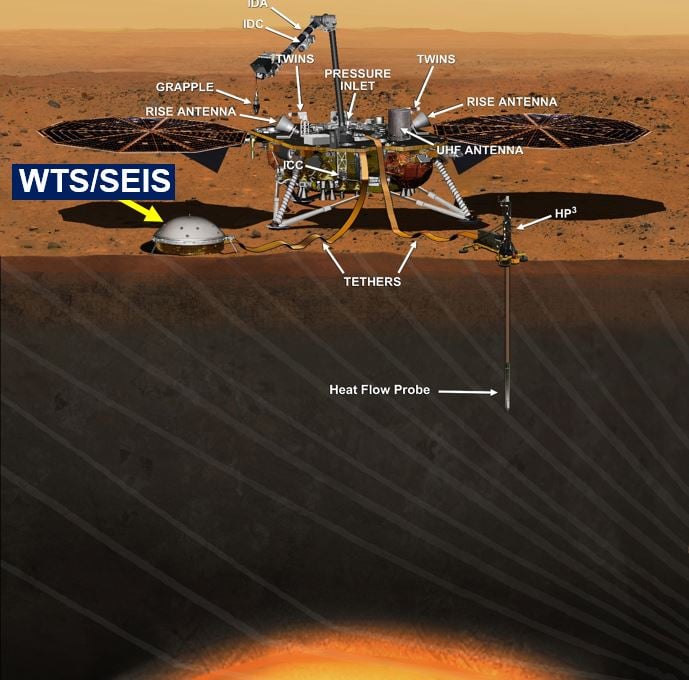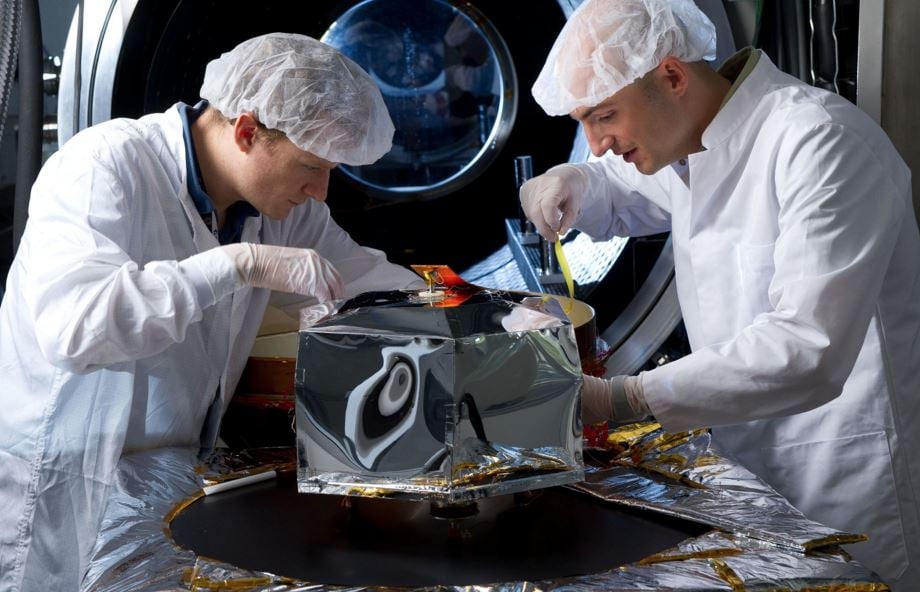The next Mars mission, InSight, has been cancelled says NASA, because of a leak in SEIS (Seismic Experiment for Interior Structure), a seismometer supplied by CNES (Centre national d’études spatiales), the French National Centre for Space Studies.
The super tiny seismometer was to be placed on the surface of the Red Planet to listen for marsquakes – faint rumblings through its crust. It is designed to detect and measure ground movement as tiny as the diameter of a single atom.
In order to work properly, it needs to operate in a quasi-vacuum so that it can withstand the harsh conditions of the environment of Mars. The air pressure must not exceed one-thousandth of a millibar – approximately one millionth of Earth’s atmospheric pressure at sea level.
 An artist’s impression of the InSight Mars lander fully deployed for studying the deep interior of Mars. The mission, which was set to launch during the period March 4 to March 30, 2016, and land on Mars Sept. 28, 2016, has been cancelled because the scientific instrument – SEIS – has a leak. (Image: nasa.gov. Credit: NASA/JPL-Caltech)
An artist’s impression of the InSight Mars lander fully deployed for studying the deep interior of Mars. The mission, which was set to launch during the period March 4 to March 30, 2016, and land on Mars Sept. 28, 2016, has been cancelled because the scientific instrument – SEIS – has a leak. (Image: nasa.gov. Credit: NASA/JPL-Caltech)
Leak could not be fixed in time
According to NASA, its decision to cancel follows failed attempts to repair a leak “in a section of the prime instrument in the science payload.”
NASA has a tiny launch window for Earth-to-Mars missions – just a few weeks every couple of years. The timeframe for the next scheduled mission was between 4th Marth and 30th March 2016 – that will be when the relative positions of Earth and Mars are most favourable for launching a mission next year.
Unless a flawless vacuum environment were achieved, the instrument’s reading would have been unreliable.
John Grunsfeld, associate administrator for NASA’s Science Mission Directorate in Washington, said:
“Learning about the interior structure of Mars has been a high priority objective for planetary scientists since the Viking era. We push the boundaries of space technology with our missions to enable science, but space exploration is unforgiving, and the bottom line is that we’re not ready to launch in the 2016 window.”
“A decision on a path forward will be made in the coming months, but one thing is clear: NASA remains fully committed to the scientific discovery and exploration of Mars.”
 CNES researchers working on the seismometer SEIS in 2014. (Image: https://cnes.fr)
CNES researchers working on the seismometer SEIS in 2014. (Image: https://cnes.fr)
Aim to learn about Mars’ formation and evolution
Bruce Banerdt, InSight Principal Investigator at NASA’s Jet Propulsion Laboratory, Pasadena, California, said:
“InSight’s investigation of the Red Planet’s interior is designed to increase understanding of how all rocky planets, including Earth, formed and evolved. Mars retains evidence about the rocky planets’ early development that has been erased on Earth by internal churning Mars lacks.”
“Gaining information about the core, mantle and crust of Mars is a high priority for planetary science, and InSight was built to accomplish this.”
 Image data from insight.snes.fr.
Image data from insight.snes.fr.
Earlier this year, a leak that had prevented SEIS from retaining vacuum conditions was fixed, and members of the mission team were hopeful that the most recent repairs also would prove successful.
Unfortunately, after thorough testing carried out on Monday at a super-low temperature (-45 °C or -49 °F), SEIS was unable to hold a vacuum.
NASA scientists and officials decided there was not enough time to resolve another leak, complete the work, carry out thorough testing and have everything ready to ensure a successful mission. Put simply, they did not think they could meet the March deadline, so the mission was cancelled.
Anomaly requires further investigation
Marc Pircher, Director of CNES’s Toulouse Space Centre, said:
“It’s the first time ever that such a sensitive instrument has been built. We were very close to succeeding, but an anomaly has occurred, which requires further investigation. Our teams will find a solution to fix it, but it won’t be solved in time for a launch in 2016.”
Maryland-based American global aerospace, defense, security and advanced technologies company, Lockheed Martin, delivered the spacecraft to Vandenberg Air Force Base in California on December 16th.
Now that the 2016 launch has been cancelled, the spacecraft will bo back to Lockheed’s facility in Denver, Colorado.
Jim Green, director, Planetary Science Division, in Washington, said:
“In 2008, we made a difficult, but correct decision to postpone the launch of the Mars Science Laboratory mission for two years to better ensure mission success. The successes of that mission’s rover, Curiosity, have vastly outweighed any disappointment about that delay.”
NASA still plans to send humans to Mars
NASA insists that this latest cancellation in no way affects its plans for sending humans to Mars, which remain “on track”.
NASA’s Mars Exploration Program started off with robotic spacecraft leading the way. In 2020, another rover will be sent to the Red Planet to join the Opportunity and Curiosity rovers that are currently exploring the planet’s surface.
According to NASA:
“NASA and CNES also are participating in the European Space Agency’s (ESA’s) Mars Express mission currently operating at Mars and plans to participate on ESA’s 2016 and 2018 ExoMars missions, including providing telecommunication radios for ESA’s 2016 orbiter and a critical element of a key astrobiology instrument on the 2018 ExoMars rover.”
JPL Director Charles Elachi said:
“The JPL and CNES teams and their partners have made a heroic effort to prepare the InSight instrument, but have run out of time given the celestial mechanics of a launch to Mars. It is more important to do it right than take an unacceptable risk.”
InSight’s science payload includes the Heat Flow and Physical Properties Package (HP3), provided by the German Aerospace Centre (DLR), and SEIS, provided by CNES.
SEIS was created with the participation of the Swiss Federal Institute of Technology (ETH), the Institut de Physique du Globe de Paris (IPGP), the Swiss Space Office, the max Plank Institute for Solar Systems Research (MPS), the European Space Agency, Imperial College London, and JPL.
NASA Video – Insight Mars Mission Animation
This NASA animation, made two years ago, shows the Insight (Interior exploration using Seismic Investigations, Geodesy and Heat Transport) Lander deploying its scientific instruments.

